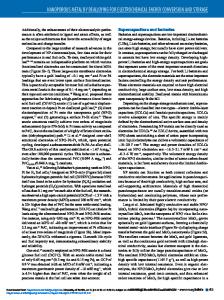Study of Nanoporous Carbon Fabrics for Rechargeable Energy Storage Capacitors
- PDF / 845,492 Bytes
- 7 Pages / 595.32 x 842.04 pts (A4) Page_size
- 17 Downloads / 332 Views
Study of Nanoporous Carbon Fabrics for Rechargeable Energy Storage Capacitors Sergey M. Karabanov1, Vladimir G. Litvinov1 and Andrey S. Karabanov2 1 Ryazan State Radio Engineering University, 59/1 Gagarina St., Ryazan 390005, Russia 2 Helios Resource Ltd., 126/1 Proletarskaya St, Saransk 430001, Russia ABSTRACT The present paper examines nanoporous material – carbon fabrics, which is used as electrodes in rechargeable energy storage capacitors (ultracapacitors). The fabrics structure, impurities composition, the influence of impurity types on ultracapacitor characteristics and the influence of thermal treatments on the impurities concentration are studied. The analysis of the ultracapacitor equivalent circuit with the studied material is made and the capacitor charge-discharge characteristics are investigated. The performed studies resulted in determination of the investigated carbon material structure, determination of impurities composition of carbon material and change of impurities content depending on thermal treatment in vacuum. The optimum temperature range for treatment in vacuum is established. The equivalent circuit of the ultracapacitor is analyzed and its charge-discharge characteristics are investigated. The chosen equivalent circuit makes it possible to estimate the influence of pores different size on the ultracapacitor charge-discharge characteristics that is important for its application in energy storage devices. INTRODUCTION Currently, ultracapacitors are widely used in power electronics, automotive industry (hybrid cars) [1,2], renewable energy [3-5]. The main component of the ultracapacitor design is the electrode system. Three types of materials are used for electrode production: carbon materials, electroconductive polymers and metal oxides [6-8]. Highly-porous carbon materials have a number of advantages: a large surface area (up to 2000 m2/g), low resistance, reasonable cost. To ensure high stability of the ultracapacitor characteristics (resistance, capacity, operating voltage), it is necessary to have carbon material with stable characteristics. The availability of impurities on the carbon fabrics surface influences significantly the carbon material characteristics: resistance, capacity. For example, oxygen affects the ultracapacitor characteristics in different ways: for ultracapacitors with nonaqueous electrolytes the availability of oxygen leads to increase of leakage currents, to operating voltage instability, etc. In ultracapacitors with aqueous electrolytes, the availability of oxygen-containing compounds, on the contrary, leads to the capacity increase [8]. The type of oxygen-containing groups (CO and CO2 groups) determines the thermal treatment mode of carbon material, at which the maximum capacity of the ultracapacitor is achieved [8]. Carbon material of different manufacturers has different impurities composition, so it is necessary to choose purification technology. The carbon fabrics structure, its impurities composition, the influence of thermal treatments on the impurities con
Data Loading...











